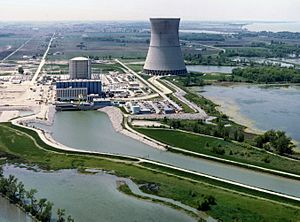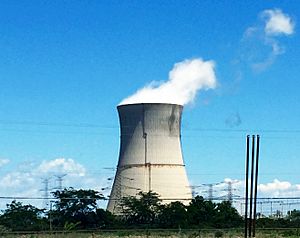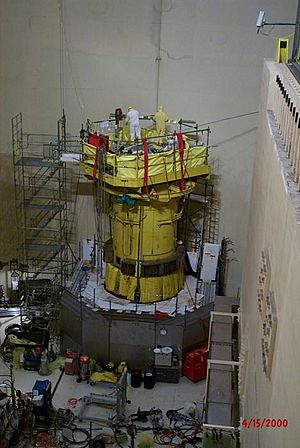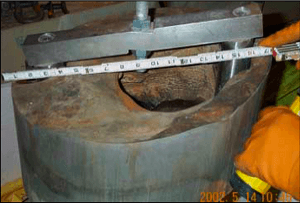Davis–Besse Nuclear Power Station facts for kids
Quick facts for kids Davis–Besse Nuclear Power Station |
|
|---|---|

The Davis–Besse NPP (NRC image)
|
|
| Country | United States |
| Location | Carroll Township, Ottawa County, near Oak Harbor, Ohio |
| Coordinates | 41°35′48″N 83°5′11″W / 41.59667°N 83.08639°W |
| Status | Operational |
| Construction began | September 1, 1970 |
| Commission date | July 31, 1978 |
| Construction cost | $2.221 billion (2007 USD) ($2.83 billion in 2021 dollars ) |
| Owner(s) | Energy Harbor |
| Operator(s) | Energy Harbor |
| Website Davis-Besse |
|
The Davis–Besse Nuclear Power Station is a large power plant in Ohio, United States. It creates 894 megawatts (MW) of electricity. This plant uses a special type of nuclear reactor called a pressurized water reactor. It is operated by a company named Energy Harbor.
Over the years, Davis–Besse has had some safety issues. The Nuclear Regulatory Commission (NRC) has said that two of the most serious nuclear incidents in the U.S. since 1979 happened here. The most important one was in March 2002. Workers found a large hole, about the size of a football, in the top part of the reactor. This hole was caused by a process called corrosion.
The NRC kept the plant closed for two years, until March 2004. This allowed the plant's owner to fix everything and make sure it was safe. The NRC also gave the company a large fine of over $5 million for the problems that led to the corrosion. The company also paid more money as part of an agreement with the United States Department of Justice (DOJ).
Davis–Besse was planned to close in 2020. This was because it was becoming too expensive to run compared to power plants that use natural gas. However, a new law in Ohio in July 2019 helped keep it open. This law added a small fee to people's electricity bills. This money helped fund Davis–Besse and another plant, the Perry Nuclear Generating Station, to keep them working.
Contents
Where is Davis–Besse and how did it start?
This power station is located on the southwest shore of Lake Erie. It's about 10 miles (16 km) north of Oak Harbor, Ohio. The plant sits on a large area of 954 acres (386 hectares).
However, only 221 acres (89 hectares) are used for the plant itself. The rest, 733 acres (297 hectares), is part of the Ottawa National Wildlife Refuge. This means the plant shares its land with a wildlife area!
Construction of the Davis–Besse plant began on September 1, 1970. It started producing electricity on July 31, 1978. It was one of the first nuclear power plants built in the United States. The plant was named after John K. Davis and Ralph M. Besse. They were important leaders at the electric companies that first owned the plant.
What is Unit One?
Davis–Besse has one main power-producing unit, called Unit One. This unit uses an 879 MW pressurized water reactor. This type of reactor uses water under high pressure to cool the nuclear fuel and create heat.
The reactor was shut down for two years, from 2002 to 2004. This was for important safety repairs and upgrades. In 2012, Unit One produced a huge amount of electricity: 7,101,700 GWh.
Were there other units planned?
Yes, in 1973, there were plans to build two more reactors, called Units Two and Three. However, these plans were later canceled in 1981. So, only Unit One was ever built and put into operation.
1985: Loss of water supply
On June 9, 1985, the main pumps that supply water to the reactor's steam generators stopped working. An operator then tried to start the emergency pumps. But these pumps also stopped because of a mistake by the operator. This event was first called a low-level emergency. Later, it was decided it should have been a more serious "site area emergency."
1998: Tornado strike
On June 24, 1998, a strong tornado hit the power station. The tornado damaged the plant's outdoor electrical equipment. This cut off the plant's connection to the main power grid.
The reactor automatically shut down to be safe. Emergency diesel generators then turned on to power the plant's important safety systems. This kept the plant safe until regular power could be brought back.
2002: Reactor head hole
In March 2002, workers found a serious problem. Water that cools the reactor had leaked from cracks above the reactor. This water had eaten a hole, about the size of a football, into the thick steel top of the reactor.
Only a thin layer of stainless steel was left holding back the very hot, high-pressure water. If this last layer had broken, a large amount of cooling water could have escaped. This could have caused serious damage to the reactor core.
Because of where the hole was, a leak might have also damaged parts needed to shut down the reactor safely. After this incident, many other important safety systems were checked and improved. These included the systems that recycle cooling water and the emergency power generators.
The repairs and upgrades took two years and cost $600 million. The Davis–Besse reactor started working again in March 2004. The NRC said this was one of the most serious nuclear incidents in the U.S. They gave the company a fine of over $5 million.
2003: Computer virus
In January 2003, a computer virus called the "slammer worm" infected the plant's computer network. This caused the plant to lose safety monitoring for five hours. This showed how important computer security is, even at power plants.
2008: Tritium leak found
In October 2008, a small leak of tritium was found by accident during a fire inspection. Tritium is a radioactive substance. Initial checks showed that the radioactive water did not spread outside the plant's property.
2010: New reactor head problems
In March 2010, during a planned shutdown for refueling, new cracks were found. These cracks were in parts of the reactor head that had been replaced after the 2002 incident. Investigators found cracks in 24 out of 69 nozzles. One crack was serious enough to leak boric acid.
Experts studied why these new cracks appeared so soon. The cracked parts were repaired using methods that had worked at other nuclear plants. The plant was able to start working again in 2010.
2011: Cracks in the shield building
In October 2011, during another maintenance shutdown, a long, thin crack was found. This crack was 30 feet (9 meters) long. It was in the concrete building that surrounds the reactor's main container.
2012: Small leak in a pump seal
On June 6, 2012, a very small leak was found in a weld of a reactor coolant pump. It was just a tiny pinhole leak. The plant reduced its power output while the cause of the leak was investigated.
2015: Steam leak shutdown
On May 9, 2015, a steam leak happened in the part of the plant that generates electricity. This caused the operators to declare an "Unusual Event" and shut down the reactor. The plant was fixed and started producing power again on May 12.
What's next for Davis–Besse?
The plant's original license to operate was going to end on April 22, 2017. But in December 2015, the NRC gave the plant a 20-year extension. This means it can now operate until April 22, 2037.
In 2018, the company that owned the plant faced financial difficulties. They announced they would close the nuclear plant. However, in 2019, Ohio lawmakers discussed a plan to help keep Davis–Besse open.
A new law, House Bill 6, was signed on July 23, 2019. This law provided money to help the plant stay open. Because of this, the company announced on July 24, 2019, that they would refuel Davis–Besse and keep it running.
How safe is it from earthquakes?
The Nuclear Regulatory Commission (NRC) studies the risk of earthquakes at nuclear power plants. For Davis–Besse, the NRC estimated that the chance of an earthquake strong enough to damage the reactor's core is about 1 in 149,254 each year. This means the risk is very low.
People living nearby
The NRC sets up two special zones around nuclear power plants for emergency planning.
- The first zone is about 10 miles (16 km) around the plant. This area is for protecting people from breathing in radioactive material if there's an accident.
- The second zone is about 50 miles (80 km) around the plant. This area is for protecting people from eating food or drinking liquids that might be contaminated.
In 2010, about 18,635 people lived within 10 miles of Davis–Besse. About 1,791,856 people lived within 50 miles. Cities like Sandusky, Ohio, Toledo, Ohio, and Detroit, Michigan are within this 50-mile zone.
The tall cooling tower at Davis–Besse is 493 feet (150 meters) high. It's a very noticeable landmark in the area. On clear days, you can even see the steam coming from the tower from over 40 miles (64 km) away!
Images for kids
See also
 In Spanish: Central Nuclear Davis-Besse para niños
In Spanish: Central Nuclear Davis-Besse para niños






